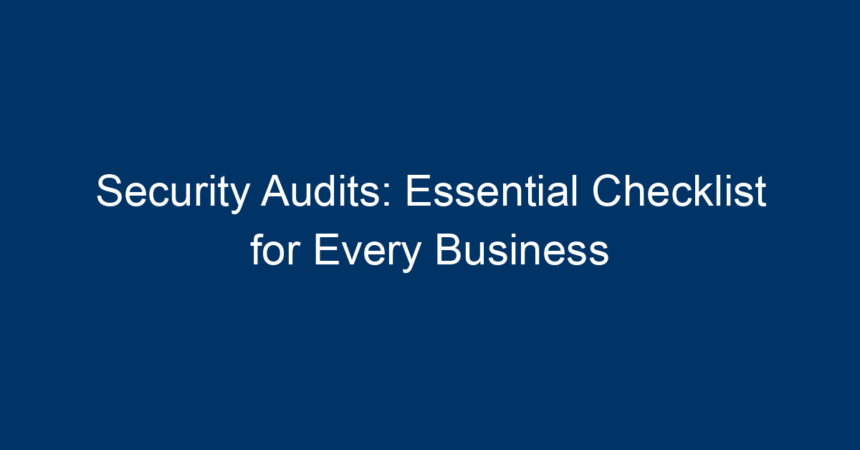In today’s digital age, the significance of security audits cannot be overstated. With cyber threats becoming more sophisticated, organizations must adopt a proactive approach to safeguard their assets and data. A security audit serves as a thorough examination of an organization’s security posture, revealing vulnerabilities and paving the way for enhanced protection. This article explores the essential checklist for conducting effective security audits, ensuring that every business is adequately prepared to confront potential threats.
What Are Security Audits?
Security audits are systematic evaluations of an organization’s security policies, practices, and controls. They assess the effectiveness of existing security measures and identify areas for improvement. By conducting regular security audits, businesses can ensure compliance with regulations, protect sensitive information, and help maintain customer trust.
Why Are Security Audits Important?
-
Risk Identification: Regular audits help identify potential risks and vulnerabilities that could be exploited by cybercriminals.
-
Regulatory Compliance: Many industries are subject to regulations that require regular security audits. Following these guidelines helps businesses avoid fines and legal repercussions.
-
Data Protection: Security audits evaluate data handling procedures and ensure that sensitive information is adequately protected.
-
Incident Response: An effective security audit can enhance incident response strategies, ensuring that organizations are prepared to react swiftly to breaches.
- Trust and Reputation: By demonstrating a commitment to security through regular audits, businesses can build trust with customers and partners, ultimately enhancing their reputation.
The Security Audit Checklist
A comprehensive security audit checklist ensures no stone is left unturned. Below are crucial sections to include in your audit.
1. Policy Review
Before diving into technical assessments, assess the existing security policies and procedures.
-
Evaluate Policies: Review policies regarding data protection, incident response, and access control.
-
Ensure Compliance: Ensure that all policies comply with relevant laws and regulations, such as GDPR or HIPAA.
- Update Procedures: Policies should be regularly updated to reflect changes in technology and threat landscapes.
2. Asset Inventory
A clear understanding of what needs to be protected is essential for any security audit.
-
Identify Assets: Create a detailed inventory of all hardware and software assets, including servers, databases, and endpoints.
-
Classify Data: Classify data based on its sensitivity and importance to the organization.
- Map Data Flows: Understand how data flows within your organization and where it is stored.
3. Vulnerability Assessment
Evaluating the organization’s vulnerabilities is crucial for a comprehensive audit.
-
Conduct Scans: Use vulnerability scanning tools to identify weaknesses in your systems.
-
Penetration Testing: Consider conducting penetration tests to simulate attacks and assess the effectiveness of your security measures.
- Remediation Planning: Develop a remediation plan for identified vulnerabilities, prioritizing them based on risk level.
4. Access Control Evaluation
Managing user access is critical for maintaining security.
-
Review User Accounts: Regularly review and update user accounts and permissions.
-
Implement Least Privilege Principle: Ensure users only have access to the data and systems necessary for their job roles.
- Multi-Factor Authentication: Encourage or enforce the use of multi-factor authentication to add an additional layer of security.
5. Network Security Assessment
Network security plays a fundamental role in protecting information.
-
Firewall Configuration: Review firewall settings to ensure they are appropriately configured to block unauthorized access.
-
Intrusion Detection Systems: Evaluate the effectiveness of intrusion detection systems in place.
- Wireless Security: Assess the security of wireless networks, ensuring they are encrypted and secured against unauthorized access.
6. Physical Security Review
Cybersecurity doesn’t just involve digital measures; physical security is equally important.
-
Access Controls: Check physical access controls to server rooms and sensitive areas.
-
Environmental Controls: Ensure that structures are protected against fire, flooding, and other environmental risks.
- Surveillance Systems: Evaluate the effectiveness of surveillance systems to ensure they adequately monitor critical facilities.
7. Incident Response and Business Continuity Planning
Effective incident response plans are vital for minimizing damage during a breach.
-
Incident Response Plan Evaluation: Review and test the current incident response plan to ensure it is up-to-date.
-
Training and Awareness: Conduct training sessions for employees to raise awareness about cyber threats and response procedures.
- Recovery Strategies: Ensure that business continuity plans are in place, and test them regularly to prepare for potential disruptions.
8. Employee Training and Awareness
Humans are often the weakest link in security. Proper training can mitigate this risk.
-
Regular Training Programs: Implement regular security awareness training for all employees.
-
Phishing Simulations: Conduct phishing simulations to assess employees’ ability to recognize potential threats.
- Reporting Mechanisms: Ensure that employees know how to report suspicious activity.
9. Third-Party Vendor Assessment
Many businesses rely on third-party vendors, which can introduce vulnerabilities.
-
Vendor Security Policies: Review the security policies of all third-party vendors and partners.
-
Risk Assessments: Conduct risk assessments on vendors to evaluate their security posture.
- Contracts and Agreements: Ensure that contracts with vendors include security requirements and accountability measures.
Conclusion: Taking Action on Security Audits
With the increasing frequency of cyber threats, security audits have emerged as an essential practice for businesses of all sizes. By utilizing this checklist and regularly conducting thorough security audits, organizations can identify vulnerabilities, improve their security posture, and safeguard their valuable assets.
Implementing the practices outlined above will not only enhance your organization’s security but also empower you to respond swiftly to any emerging threats. Make security audits an integral part of your organizational strategy to foster a culture of security awareness and protect your reputation in an ever-evolving digital landscape.
Remember, a proactive approach is always better than a reactive one. Regular audits, combined with ongoing employee education and strong security measures, will pave the way for a more secure business environment. Prioritize security today to safeguard your business for tomorrow.




